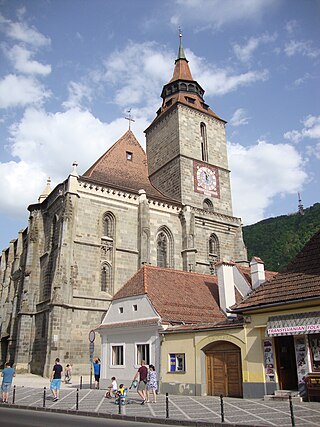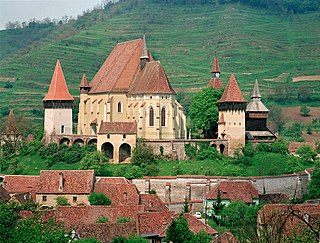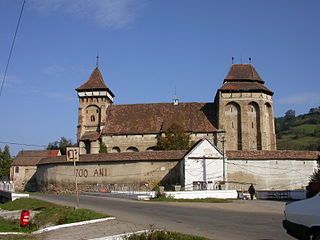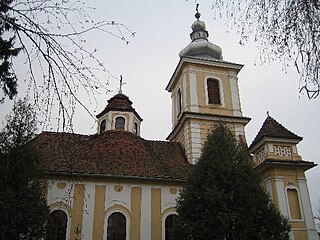
The St. Michael's Church is a Gothic-style Roman Catholic church in Cluj-Napoca. It is the second largest church in the geographical region of Transylvania, Romania. The nave is 50 meters long and 24 meters wide, the apse is 20×10 m. The tower with its height of 76 meter is the highest one in Transylvania.

The Lutheran Cathedral of Saint Mary is the most famous Gothic-style church in Sibiu, Transylvania, central Romania. Its massive 73.34 m high steeple is a landmark of the city. The four turrets situated on top of the steeple are said to have been a sign to let foreigners know that the town had the right to sentence to death. It belongs to the Lutheran, German-speaking Evangelical Church of Augustan Confession in Romania.

The Evangelical Church of the Augsburg Confession in Romania is a German-speaking Lutheran church in Romania, mainly based in Transylvania. As a Lutheran church, it adheres to the Augsburg Confession. Its history goes back to the 12th century when the Transylvanian Saxons arrived in the region, then part of the Kingdom of Hungary.

The Church of the Holy Archangels Michael and Gabriel, located in Piața Traian in the center of Brăila, Romania, is a Romanian Orthodox church.

The Church of the Holy Archangels is one of eight Wooden Churches of Maramureş in Romania listed as a UNESCO World Heritage Site in December 1999. The structure is in the village of Rogoz in the Lăpuș River valley within the mountainous area of northern Transylvania.

The Biertan fortified church is a Lutheran fortified church in Biertan, Sibiu County, in the Transylvania region of Romania. It was built by the ethnic German Transylvanian Saxon community at a time when the area belonged to the Kingdom of Hungary. Briefly Roman Catholic, it became Evangelical Lutheran following the Reformation. Together with the surrounding village, the church forms part of the villages with fortified churches in Transylvania UNESCO World Heritage Site.

The Saschiz fortified church is a Lutheran fortified church in Saschiz (Keisd), Mureș County, in the Transylvania region of Romania. It was built by the ethnic German Transylvanian Saxon community at a time when the area belonged to the Kingdom of Hungary. Initially Roman Catholic, it became Lutheran following the Reformation. Together with the surrounding village, the church forms part of the villages with fortified churches in Transylvania UNESCO World Heritage Site.

The Valea Viilor fortified church is a Lutheran fortified church in Valea Viilor (Wurmloch), Sibiu County, in the Transylvania region of Romania. It was built by the ethnic German Transylvanian Saxon community at a time when the area belonged to the Kingdom of Hungary. Initially Roman Catholic, it became Lutheran following the Reformation. Together with the surrounding village, the church forms part of the villages with fortified churches in Transylvania UNESCO World Heritage Site.

The Roșia fortified church is a Lutheran fortified church in Roșia, Sibiu County, in the Transylvania region of Romania. It was built by the ethnic German Transylvanian Saxon community at a time when the area belonged to the Kingdom of Hungary. Initially Roman Catholic, it became Lutheran following the Protestant Reformation.

The Annunciation Church, also known as the Church in the Ditch, is a Romanian Orthodox church located at 5 Justiției Street in the Transylvanian city of Sibiu.

Jesuit Church, otherwise the Church of the Holy Trinity, is a Roman Catholic church located at 3 Piața Mare, Sibiu, Romania. Immediately adjacent to Brukenthal Palace, it is one of the most notable baroque churches in Transylvania.

St. Margaret's Church is a Lutheran church, located at 1 Piața Castelului in the historic town center of Mediaș (Mediasch), Sibiu County, in the Transylvania region of Romania.

The Church between the Fir trees, otherwise the Church of Saints Peter and Paul, is a Romanian Orthodox church located at 17 Reconstrucției Street, Sibiu, Romania.

Motiș fortified church is a historic Lutheran church in the village of Motiș in Valea Viilor Commune, Sibiu County, Transylvania, Romania that was historically home to a large Transylvanian Saxon (German) population.

The St. Elijah Church is a Romanian Orthodox church in the Fabric district of Timișoara.

The Misericordia Church, also known as the Cetate Greek Catholic Church, is a Greek Catholic church located in Timișoara's 700 Square. Dedicated to St. Joseph, the church belonged to the Order of the Misericordia and was built between 1748 and 1753. It is the second oldest church in Timișoara and houses the largest icon of St. Joseph in Romania as well as the oldest organ in Banat.

St. Catherine Church is a Roman Catholic church on János Bolyai Street in the Cetate district of Timișoara. The church currently serves the Slovak Catholic community in Timișoara.

The Lutheran Church is a Lutheran church in the Cetate district of Timișoara. It is the only Lutheran church in Timișoara, the Lutheran community here numbering about 400 people and being composed of Germans, Hungarians, Slovaks and Romanians. The religious service is officiated in all four languages. Nowadays, the church occasionally hosts baroque music concerts, choral performances, classical music concerts or organ concerts.

The St. Nicholas Church is a Romanian Orthodox church at 12 Ana Aslan Street in Brăila, Romania. It is the second oldest such building in the city, the first being the Church of the Holy Archangels Michael and Gabriel, and was built on the site of an older church that was burnt down by a fire. For a time it was the tallest building in the city, and thus, its bell tower served as an observation point for firefighters of Brăila to prevent fires.



















